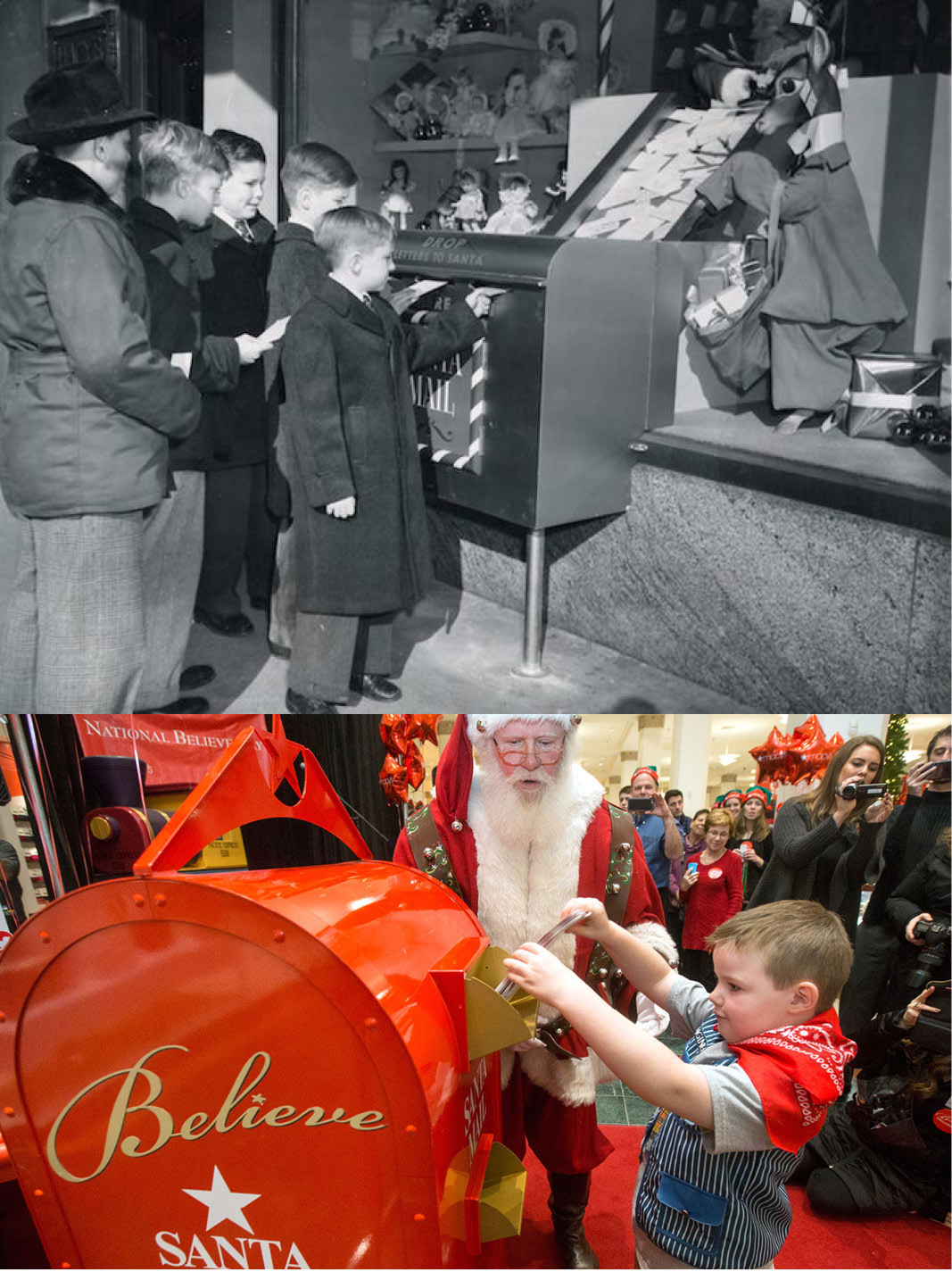A Unique Year for a Special Parade

The Macy’s Thanksgiving Day Parade. Floats and balloons and fun, oh, my!!!
I hope you enjoyed your augmented Thanksgiving yesterday with loved ones and also had a chance to see some of the parade. As a kid, my brothers and sisters always found time to turn on the Macy’s parade and to see the balloons, bands, movie stars and of course Santa. Mom used to say that Santa is now watching us until Christmas Day, so we have to be extra good. My favorite of course was the giant balloons. We used to laugh at the people singing as you could tell they were just mouthing along with the words. I was always amazed at how the folks didn’t just blow away while trying to hold onto the balloons. I had the opportunity after Jackie and I were married to march in a parade as a huge balloon “holder person” in Toledo. I have to say there is definitely a system involved especially when there is a walkway over the street that the balloon has to get under! My girls have grown up watching parts of the parade in between family football games and getting ready for Thanksgiving dinner. I did some digging and found cool information about the parade and its origins. Relax and enjoy your extended weekend. Special thanks to Wikipedia for the info.
- The annual Macy’s Thanksgiving Day Parade in New York City, the world’s largest parade, is presented by the U.S. based department store chain Macy’s. The parade started on November 27, 1924, tying it for the second-oldest Thanksgiving parade in the United States with America’s Thanksgiving Parade in Detroit (with both parades being four years younger than Philadelphia’s Thanksgiving Day Parade). The three-hour parade is held in Manhattan, ending outside Macy’s Herald Square, and takes place from 9:00 a.m. to 12:00 p.m. EST on Thanksgiving Day.
- In 1924, store employees marched to Macy’s Herald Square, the flagship store on 34th Street, dressed in vibrant costumes. There were floats, professional bands and live animals borrowed from the Central Park Zoo. At the end of that first parade, Santa Claus was welcomed into Herald Square and was enthroned on the Macy’s balcony at the 34th Street store entrance, where he was then crowned “King of the Kiddies”. With an audience of over 250,000 people, the parade was such a success that Macy’s declared it would become an annual event, despite media reports only barely covering the first parade.
- The Macy’s parade was enough of a success to push Ragamuffin Day, the typical children’s Thanksgiving Day activity from 1870 into the 1920s, into obscurity. Ragamuffin Day featured children going around and performing a primitive version of trick-or-treating, a practice that by the 1920s had come to annoy most adults. The public backlash against such begging in the 1930s, at a time when most Americans were themselves struggling in the midst of the Great Depression, led to promotion of alternatives, including Macy’s parade.
- Anthony “Tony” Frederick Sarg loved to work with marionettes from an early age. After moving to London to start his own marionette business, Sarg moved to New York City to perform with his puppets on the street. Macy’s heard about Sarg’s talents and asked him to design a window display of a parade for the store.

- The balloons were introduced in 1928, replacing live zoo animals. Sarg’s large animal-shaped balloons were produced by the Goodyear Tire and Rubber Company in Akron, Ohio. That year there was no procedure to deflate the balloons so they were simply released. In 1928 five of the larger balloons were designed and filled with helium to rise above 2,000 feet and slowly deflate for whomever was lucky enough to capture the contestants in Macy’s “balloon race” and return them for a reward of $100 (equivalent to more than $1,500 with inflation as of 2020) – this lasted until 1932.
- Through the 1930s, the Parade continued to grow, with crowds of over one million people lining the parade route in 1933. The first Mickey Mouse balloon entered the parade in 1934. The annual festivities were broadcast on local radio stations in New York City from 1932 to 1941, and resumed in 1945, running through 1951.
- The parade was suspended from 1942 to 1944 as a result of World War II, because rubber and helium were needed for the war effort. The parade resumed in 1945, and became known nationwide shortly afterward, having been prominently featured in the 1947 film Miracle on 34th Street, which included footage of the 1946 festivities. The event was first broadcast on network television in 1948
- The balloons in the Macy’s Thanksgiving Day Parade have had several varieties. The oldest is the novelty balloon class, consisting of smaller balloons ranging widely in size and handled by between one and thirty people (the smallest balloons are shaped like human heads and fit on the heads of the handlers). The larger and more popular class is the character balloons, primarily consisting of licensed pop-culture characters; each of these is handled by exactly 90 people. From 2005 to 2012, a third balloon class, the “Blue Sky Gallery”, transformed the works of contemporary artists into full-size balloons; after a five-year hiatus, the Blue Sky Gallery returned in 2018.
- In addition to the well-known balloons and floats, the Parade also features live music and other performances. College and high school marching bands from across the country participate in the parade, and the television broadcasts feature performances by established and up-and-coming singers and bands. The Rockettes of Radio City Music Hall are a classic performance as well, having performed annually since 1957, as the last pre-parade act to perform and their performance was followed by a commercial break, as are cheerleaders and dancers chosen by the National Cheerleaders Association from various high schools across the country. The parade concludes with the arrival of Santa Claus to ring in the Christmas and holiday season
- On the NBC telecast the marching bands perform live music. Most “live” performances by musicals and individual artists lip sync to the studio, soundtrack or cast recordings of their songs. Although rare, recent parade broadcasts have featured at least one live performance with no use of recorded vocals. Cast members from a number of Broadway shows perform either in the parade, or immediately preceding the parade in front of Macy’s and before The Rockettes’ performance
- For the 10th anniversary of the September 11th attacks in 2011, the Macy’s Thanksgiving Parade invited family members from Tuesday’s Children, a family service organization that has made a long-term commitment to those directly impacted by the attacks and terrorism around the world, to cut the ribbon at the start of the parade.
- More than 44 million people typically watch the parade on television on an annual basis. It was first televised locally in New York City in 1939 as an experimental broadcast on NBC’s W2XBS (forerunner of today’s WNBC). The parade began its network television appearances on CBS in 1948, the year that major, regular television network programming began. NBC has been the official broadcaster of the event since 1953, though CBS (which has a studio in Times Square) also carries unauthorized coverage under the title The Thanksgiving Day Parade on CBS
- Since 2003, the parade has been broadcast simultaneously in Spanish on the sister network of NBCUniversal (Telemundo) hosted by María Celeste Arrarás from 2003-2006. The parade won nine Emmy Awards for outstanding achievements in special event coverage since 1979.
- Other American cities also have parades held on Thanksgiving, none of which are run by Macy’s. The nation’s oldest Thanksgiving parade (the Gimbels parade, which has had many sponsors over the years, and is now known as the 6abc Dunkin’ Donuts Thanksgiving Day Parade) was first held in Philadelphia in 1920. Other cities with parades on the holiday include the McDonald’s Thanksgiving Parade in Chicago, Illinois and parades in Plymouth, Massachusetts; Seattle, Washington; Houston, Texas; Detroit, Michigan; and Fountain Hills, Arizona.
- The 2018 parade was the coldest to date with the temperature at 19 °F. The warmest was in 1933 at 69 °F. The 2006 parade was the wettest with 1.72″ (49 mm) of rain.
- In August 2020, due to the COVID-19 pandemic in New York City, Macy’s stated that it planned to change the format of the parade in accordance with New York health orders. The parade is being produced as a “television-only special presentation” over a two-day period, with 75% fewer participants and social distancing enforced. The event will not include college and high school marching bands nor any participant under 18 years of age. Balloons will be tethered to a “specially rigged anchor vehicle framework of five specialty vehicles” rather than carried by handlers, and the full parade route will not be used — with all activity limited to the Herald Square area.

::::::::::::::::::::::::::::::::::::::::::::::::::::::::::::::::::::::::::::::::::::::::::
DO YOU LIKE CONTESTS?
Me, too.
As you may know the Kowalski Heat Treating logo finds its way
into the visuals of my Friday posts.
I. Love. My. Logo.
One week there could be three logos.
The next week there could be 15 logos.
And sometimes the logo is very small or just a partial logo showing.
But there are always logos in some of the pictures.
So, I challenge you, my beloved readers, to count them and send me a
quick email with the total number of logos in the Friday post.
On the following Tuesday I’ll pick a winner from the correct answers
and send that lucky person some great KHT swag.
So, start counting and good luck!
Oh, and the logos at the very top header don’t count.
Got it? Good. :-))))
Have fun!!
::::::::::::::::::::::::::::::::::::::::::::::::::::::::::::::::::::::::::::::::::::::::::







 I love apple pie. So, I always get way more apples than needed for a pie. You know why? Because I also love to eat apples. Apples in the morning. Apples at lunch. Apples for an afternoon snack. An apple after my evening run. So, I ALWAYS get way more apples than needed for a pie. :)))
I love apple pie. So, I always get way more apples than needed for a pie. You know why? Because I also love to eat apples. Apples in the morning. Apples at lunch. Apples for an afternoon snack. An apple after my evening run. So, I ALWAYS get way more apples than needed for a pie. :)))


